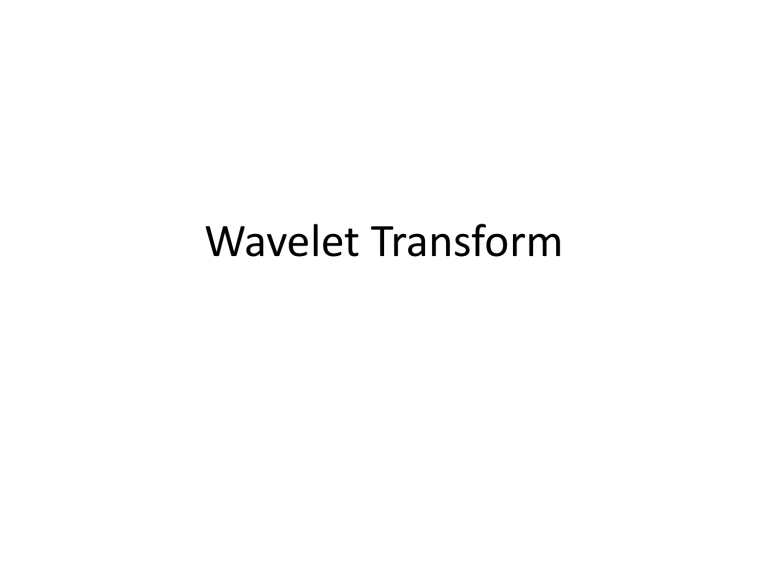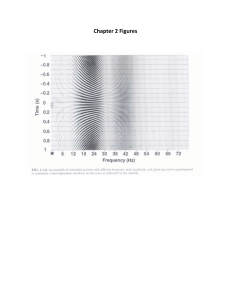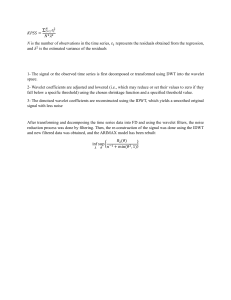
Wavelet Transform • Fourier theory: a signal can be expressed as the sum of a, possibly infinite, series of sines and cosines. • This sum is also referred to as a Fourier expansion. • The big disadvantage of a Fourier expansion, however, is that it has only frequency resolution and no time resolution. • Although we might be able to determine all the frequencies present in a signal, we do not know when (or where) they are present. • To overcome this problem in the past decades several solutions have been developed which are more or less able to represent a signal in the time and frequency domain at the same time. Windowing • The idea behind these time-frequency joint representations is to cut the signal of interest into several parts and then analyze the parts separately. • It is clear that analyzing a signal this way will give more information about the when and where of different frequency components, but it leads to a fundamental problem as well: how to cut the signal? Short window in time domain – Large spread in frequency domain • The problem here is that cutting the signal corresponds to a convolution between the signal and the cutting window. • Since convolution in the time domain is identical to multiplication in the frequency domain and since the Fourier transform of a Dirac pulse contains all possible frequencies the frequency components of the signal will be smeared out all over the frequency axis. • In fact this situation is the opposite of the standard Fourier transform since we now have time resolution but no frequency resolution whatsoever. Uncertainty Principle • The underlying principle of the phenomena just described is Heisenberg ’s uncertainty principle, which, in signal processing terms, states that it is impossible to know the exact frequency and the exact time of occurrence of this frequency in a signal. • In other words, a signal can simply not be represented as a point in the time-frequency space. Wavelet Analysis • The wavelet transform or wavelet analysis is probably the most recent solution to overcome the shortcomings of the Fourier transform. • In wavelet analysis the use of a fully scalable modulated window solves the signal-cutting problem. • The window is shifted along the signal and for every position the spectrum is calculated. • Then this process is repeated many times with a slightly shorter (or longer) window for every new cycle. • In the end the result will be a collection of time-frequency representations of the signal, all with different resolutions. Multiresolution analysis • Because of this collection of representations we can speak of a multiresolution analysis. • In the case of wavelets we normally do not speak about time-frequency representations but about time-scale representations, scale being in a way the opposite of frequency, because the term frequency is reserved for the Fourier transform. • Since from literature it is not always clear what is meant by small and large scales, we will define it here as follows: • the large scale is the big picture, while the small scales show the details. • Thus, going from large scale to small scale is in this context equal to zooming in. Continuous Wavelet Transform • The wavelet analysis is known as the continuous wavelet transform or CWT. where * denotes complex conjugation. • This equation shows how a function f(t) is decomposed into a set of basis functions ψs,τ(t), called the wavelets. Mother wavelet • The wavelets are generated from a single basic wavelet ψ(t), the so-called mother wavelet, by scaling and translation: • It is important to note that in (1) and (3) the wavelet basis functions are not specified. • This is a difference between the wavelet transform and the Fourier transform, or other transforms. • The theory of wavelet transforms deals with the general properties of the wavelets and wavelet transforms only. It defines a framework within one can design wavelets to taste and wishes. • One of the most important properties of wavelets are the admissibility condition where ψ(w) is the Fourier transform of ψ(t). • The admissibility condition implies that the Fourier transform of ψ( t) vanishes at the zero frequency, i.e. • A zero at the zero frequency also means that the average value of the wavelet in the time domain must be zero, • and therefore it must be oscillatory. In other words, ψ( t) must be a wave. Redundancy in CWT • As can be seen from (1) the wavelet transform of a onedimensional function is two-dimensional; the wavelet transform of a two-dimensional function is fourdimensional. • In (1) the wavelet transform is calculated by continuously shifting a continuously scalable function over a signal and calculating the correlation between the two. • These functions will be nowhere near an orthogonal basis, and the obtained wavelet coefficients will therefore be highly redundant. • For most practical applications we would like to remove this redundancy. Discrete Wavelet Transform • As mentioned before the CWT maps a onedimensional signal to a two-dimensional time-scale joint representation that is highly redundant. • To overcome this problem discrete wavelets have been introduced. • Discrete wavelets are not continuously scalable and translatable but can only be scaled and translated in discrete steps. scale time Discrete Wavelet Transform • Although it is called a discrete wavelet, it normally is a (piecewise) continuous function. • In (10), j and k are integers and s0>1 is a fixed dilation step. • The translation factor τ0 depends on the dilation step. • The effect of discretizing the wavelet is that the time-scale space is now sampled at discrete intervals. Discrete Wavelet Transform • We usually choose s0 = 2 and τ0 = 1 so that the sampling of the frequency axis corresponds to dyadic sampling. • When discrete wavelets are used to transform a continuous signal the result will be a series of wavelet coefficients, and it is referred to as the wavelet series decomposition . • An important issue in such a decomposition scheme is of course the question of reconstruction. • It is all very well to sample the time-scale joint representation on a dyadic grid, but if it will not be possible to reconstruct the signal it will not be of great use. • As it turns out, it is indeed possible to reconstruct a signal from its wavelet series decomposition. • In [Dau92] it is proven that the necessary and sufficient condition for stable reconstruction is that the energy of the wavelet coefficients must lie between two positive bounds, • [Dau92] Daubechies, I. TEN LECTURES ON WAVELETS. 2nd ed. Philadelphia: SIAM, 1992. CBMS-NSF regional conference series in applied mathematics 61. • The last step we have to take is making the discrete wavelets orthonormal. This can be done only with discrete wavelets. • The discrete wavelets can be made orthogonal to their own dilations and translations by special choices of the mother wavelet, which means: • An arbitrary signal can be reconstructed by summing the orthogonal wavelet basis functions, weighted by the wavelet transform coefficients • Orthogonality is not essential in the representation of signals. • The wavelets need not be orthogonal and in some applications the redundancy can help to reduce the sensitivity to noise [She96] or improve the shift invariance of the transform [Bur98]. • This is a disadvantage of discrete wavelets: the resulting wavelet transform is no longer shift invariant, which means that the wavelet transforms of a signal and of a time-shifted version of the same signal are not simply shifted versions of each other. • [She96] Sheng, Y. WAVELET TRANSFORM. In: The transforms and applications handbook. Ed. by A. D. Poularikas. P. 747-827. Boca Raton, Fl (USA): CRC Press, 1996. The Electrical Engineering Handbook Series. • [Bur98] Burrus, C. S. and R. A. Gopinath , H. Guo . INTRODUCTION TO WAVELETS AND WAVELET TRANSFORMS, A PRIMER. Upper Saddle River, NJ (USA): Prentice Hall, 1998. • Even with discrete wavelets we still need an infinite number of scalings and translations to calculate the wavelet transform. • The easiest way to tackle this problem is simply not to use an infinite number of discrete wavelets. • Of course this poses the question of the quality of the transform. • Is it possible to reduce the number of wavelets to analyze a signal and still have a useful result? • The translations of the wavelets are of course limited by the duration of the signal under investigation so that we have an upper boundary for the wavelets. • This leaves us with the question of dilation: how many scales do we need to analyze our signal? How do we get a lower bound? • It turns out that we can answer this question by looking at the wavelet transform in a different way. Wavelet in the frequency domain • If we look at (5) we see that the wavelet has a band-pass like spectrum. • From Fourier theory we know that compression in time is equivalent to stretching the spectrum and shifting it upwards: • This means that a time compression of the wavelet by a factor of 2 will stretch the frequency spectrum of the wavelet by a factor of 2 and also shift all frequency components up by a factor of 2. • Using this insight we can cover the finite spectrum of our signal with the spectra of dilated wavelets in the same way as that we covered our signal in the time domain with translated wavelets. • Summarizing, if one wavelet can be seen as a bandpass filter, then a series of dilated wavelets can be seen as a band-pass filter bank. • If we look at the ratio between the center frequency of a wavelet spectrum and the width of this spectrum we will see that it is the same for all wavelets. • This ratio is normally referred to as the fidelity factor Q of a filter and in the case of wavelets one speaks therefore of a constant-Q filter bank. Subband Coding • We still do not know how to calculate the wavelet transform. Therefore we will continue our journey through multiresolution land. • If we regard the wavelet transform as a filter bank, then we can consider wavelet transforming a signal as passing the signal through this filter bank. • The outputs of the different filter stages are the wavelet and scaling function transform coefficients. • Analyzing a signal by passing it through a filter bank is not a new idea and has been around for many years under the name subband coding. • It is used for instance in standard DSP applications. • The filter bank needed in subband coding can be built in several ways. One way is to build many band-pass filters to split the spectrum into frequency bands. • The advantage is that the width of every band can be chosen freely, in such a way that the spectrum of the signal to analyze is covered in the places where it might be interesting. • The disadvantage is that we will have to design every filter separately and this can be a time consuming process. • Another way is to split the signal spectrum in two (equal) parts, a low-pass and a high-pass part. The high-pass part contains the smallest details we are interested in and we could stop here. • We now have two bands. However, the low-pass part still contains some details and therefore we can split it again. And again, until we are satisfied with the number of bands we have created. • In this way we have created an iterated filter bank. • Usually the number of bands is limited by for instance the amount of data or computation power available. • The advantage of this scheme is that we have to design only two filters, the disadvantage is that the signal spectrum coverage is fixed. • Looking at figure 4 we see that what we are left with after the repeated spectrum splitting is a series of band-pass bands with doubling bandwidth and one low-pass band. • In other words, we can also perform the same subband analysis by feeding the signal into a bank of band-pass filters of which each filter has a bandwidth twice as wide as his left neighbor. • From this we can conclude that a wavelet transform is the same thing as a subband coding scheme using a constant-Q filter bank [Mal89a]. In general we will refer to this kind of analysis as a multiresolution analysis. • Mallat, S. G. A THEORY FOR MULTIRESOLUTION SIGNAL DECOMPOSITION: THE WAVELET REPRESENTATION. IEEE Transactions on Pattern Analysis and Machine Intelligence, Vol. 11, No. 7 (1989), p. 674-693.



